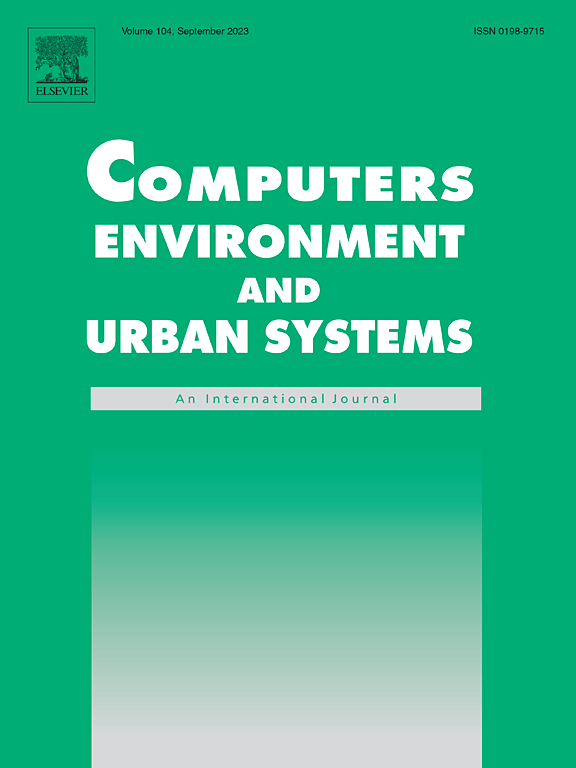主观身体障碍与行人数量的关联:一个大城市数据和机器学习方法
IF 8.3
1区 地球科学
Q1 ENVIRONMENTAL STUDIES
Computers Environment and Urban Systems
Pub Date : 2025-09-02
DOI:10.1016/j.compenvurbsys.2025.102348
引用次数: 0
摘要
城市地区的物理障碍的特征是其建成环境的可见破坏、腐烂和恶化,如破碎的窗户、涂鸦和垃圾。虽然它对心理健康、犯罪率和生活满意度的负面影响是有据可查的,但它对行人数量的影响——城市活力和宜居性的重要指标——却很少被讨论。此外,以前的研究主要依赖于身体障碍的客观测量,忽视了主观感知,并可能导致有偏见的解释。为了解决这些重要的研究空白,我们开发了一项在线视觉调查,从五个维度评估中国上海的感知物理障碍:建筑障碍、商业障碍、道路障碍、绿化障碍和基础设施障碍。然后,我们利用不同的机器学习算法来预测全市范围内基于高层街道元素和低层特征的物理障碍的空间模式。最后,我们研究了城市身体障碍与行人数量之间的关系,并按年龄和性别进行了分类。我们的研究结果揭示了不同类型的主观身体障碍对行人数量的影响在人口统计学上的差异。此外,主观身体障碍为解释集体步行行为提供了对现有建筑环境因素的有价值的补充。值得注意的是,绿化障碍与女性、成人和老年行人的步行行为呈显著负相关,而基础设施障碍主要影响年轻行人。利用大数据,这一主观测量框架使身体障碍的人口敏感评估系统以及有针对性的干预措施能够减少感知到的身体障碍,并改善不同人群的步行能力。本文章由计算机程序翻译,如有差异,请以英文原文为准。
The association of subjective physical disorder and pedestrian volume: A big urban data and machine-learning approach
Physical disorder in an urban area is characterized by visible damage, decay, and deterioration in its built environment, such as broken windows, graffiti, and litter. While its adverse effects on mental health, crime rates, and life satisfaction are well-documented, its impact on pedestrian volume–an essential indicator of urban vibrancy and livability–remains poorly discussed. Moreover, previous studies have predominantly relied on objective measures of physical disorder, overlooking subjective perceptions and potentially leading to biased interpretations. To address these crucial research gaps, we developed an online visual survey to evaluate the perceived physical disorder in Shanghai, China, across five dimensions: architectural disorder, commercial disorder, road disorder, greenery disorder, and infrastructure disorder. Then, we leveraged diverse machine learning algorithms to predict citywide spatial patterns of physical disorder based on both high-level street elements and low-level features. Finally, we examined the associations between urban physical disorder and pedestrian volumes, categorized by age and gender. Our findings reveal disparities in the influence of different types of subjective physical disorder on pedestrian volumes by demographic groups. Moreover, the subjective physical disorder provides a valuable supplement to existing built environment factors in explaining collective walking behavior. Notably, greenery disorder exhibits a significant negative association with walking behavior among female, adult, and elderly pedestrians, whereas infrastructure disorder predominantly impacts young pedestrians. Leveraging big data, this subjective measurement framework enables demographically sensitive evaluation systems of physical disorder as well as targeted interventions to reduce perceived physical disorder and improve walkability for different population groups.
求助全文
通过发布文献求助,成功后即可免费获取论文全文。
去求助
来源期刊

Computers Environment and Urban Systems
Multiple-
CiteScore
13.30
自引率
7.40%
发文量
111
审稿时长
32 days
期刊介绍:
Computers, Environment and Urban Systemsis an interdisciplinary journal publishing cutting-edge and innovative computer-based research on environmental and urban systems, that privileges the geospatial perspective. The journal welcomes original high quality scholarship of a theoretical, applied or technological nature, and provides a stimulating presentation of perspectives, research developments, overviews of important new technologies and uses of major computational, information-based, and visualization innovations. Applied and theoretical contributions demonstrate the scope of computer-based analysis fostering a better understanding of environmental and urban systems, their spatial scope and their dynamics.
 求助内容:
求助内容: 应助结果提醒方式:
应助结果提醒方式:


